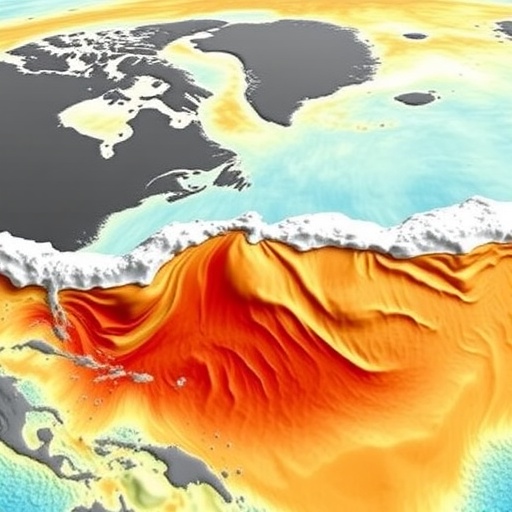In a groundbreaking study published in the journal Science, researchers have unveiled a pivotal revision to our understanding of global sea level fluctuations during the last ice age, fundamentally altering the narrative that has prevailed for decades. By reconstructing sea level changes over the past 4.5 million years, the team has demonstrated that significant oscillations in ice sheet growth and decay were not confined only to the later stages of the Pleistocene epoch but occurred repeatedly throughout the entire period. This revelation challenges long-standing theories about the middle Pleistocene transition and calls for a re-examination of the climatic forces shaping Earth’s glacial history.
The Pleistocene epoch, spanning roughly from 2.6 million to 11,700 years ago, has traditionally been characterized by cyclical expansions and contractions of vast ice sheets across the Northern Hemisphere. These cycles, driven by complex interactions between orbital forcing and greenhouse gas concentrations, have been studied extensively, with prior models suggesting a notable shift in glaciation dynamics occurring between 1.25 million and 700,000 years ago. This interval, termed the middle Pleistocene transition, was believed to mark a shift from 41,000-year glacial cycles to longer 100,000-year cycles with amplified ice volume changes.
For nearly half a century, scientific consensus posited that ice sheets were smaller and their cycles less intense prior to this transition, based largely on proxy data from foraminiferal shells embedded in ocean sediments. These microscopic marine organisms, sensitive to changes in water chemistry and temperature, provide crucial records of past climate and sea level through isotopic composition preserved in sediment cores. The conventional interpretation emphasized external climatic drivers, including shifts in atmospheric CO₂ and orbital parameters, as primary mechanisms behind the observed change in ice sheet behavior.
In contrast, the new research led by Peter Clark, a distinguished paleoclimatologist at Oregon State University, paints a different picture. By integrating an extensive data set spanning millions of years and employing sophisticated statistical reconstructions, the study reveals that many glaciation cycles during the early Pleistocene reached magnitudes comparable to those seen after the middle Pleistocene transition. This implies that large ice sheets were already present and undergoing substantial growth and decay throughout this earlier epoch, contesting the notion that such phenomena emerged abruptly around 1 million years ago.
Clark explains that this finding necessitates a shift from viewing glaciation changes as resulting solely from external forcings to considering the role of internal feedback mechanisms within the Earth’s climate system. Feedbacks concerning ice sheet dynamics, including ice flow, basal lubrication, and interactions with the atmosphere and ocean, may have significantly influenced the timing and amplitude of glacial cycles. This internal complexity offers a new framework for understanding paleoclimate variability beyond simplistic orbital explanations.
The implications of these results are profound, extending beyond academic discourse into contemporary concerns about ice sheet stability and sea level rise. Presently, Earth harbors two major ice sheets—Antarctica and Greenland—both integral to global climate regulation and oceanic circulation. Understanding their past behavior under diverse climate states enhances predictive models for future changes amid anthropogenic warming. The study underscores how ice sheet-climate interactions have long been nuanced and dynamic, cautioning against linear assumptions about ice sheet responses to environmental shifts.
Notably, the research builds upon earlier collaborative efforts aimed at reconstructing prehistorical global atmospheric and ocean temperatures, an initiative launched in 2017 to deepen insight into the drivers of long-term climate change. These temperature reconstructions provide vital context for interpreting sea level trends and ice volume fluctuations, making the integrated approach particularly compelling. By synthesizing multiple lines of evidence, from marine sediments to climate proxies, the investigators provide a robust and nuanced narrative of Earth’s glacial past.
This research also revitalizes discussions surrounding the middle Pleistocene transition itself. Previously, hypotheses centered either on decreasing greenhouse gas concentrations, especially carbon dioxide, as the primary catalyst or on geophysical changes affecting ice sheet mechanics, such as basal conditions or lithospheric adjustments. The new findings suggest that neither explanation fully accounts for the complexities observed, instead indicating a combination of factors orchestrated by both internal climate dynamics and external forcings.
Examining the methodological innovations underpinning this study reveals the advanced analytical techniques that have facilitated these insights. High-resolution isotopic analyses of foraminifera, combined with sophisticated age modeling and sediment core correlation, allow for precise reconstructions spanning millions of years. Enhanced computational models simulate ice sheet behavior under varying climatic conditions, yielding realistic scenarios consistent with empirical data. This methodological synthesis exemplifies the interdisciplinary cooperation essential for advancing paleoclimatology.
The team’s extensive collaboration across multiple institutions further reflects the global significance of these findings. Researchers from Oregon State University, Boston College, Rutgers University, Pennsylvania State University, the Alfred Wegener Institute of Germany, University of Oregon, University of Reading, Chinese Academy of Sciences, Harvard University, and Ohio State University contributed their expertise, underscoring the complexity and scope of the project. Such a multidisciplinary approach embodies the collaborative spirit needed to tackle Earth’s climatic enigmas.
Ultimately, this paradigm shift not only redefines our comprehension of Earth’s glacial history but also invigorates the scientific community to reconsider existing climate models and predictions. By recognizing that large ice sheets and substantial sea level variations characterized much of the Pleistocene, scientists are better equipped to explore the multifaceted interactions between atmosphere, ocean, and cryosphere that have governed Earth’s environmental rhythms for millions of years. As contemporary climate change accelerates, these lessons from the past offer critical guidance in anticipating and mitigating future impacts on our planet’s frozen frontiers.
Subject of Research: Reconstruction of global mean sea level changes and ice sheet dynamics during the Pleistocene epoch.
Article Title: Global mean sea level over the past 4.5 million years
News Publication Date: 16-Oct-2025
Web References: DOI: 10.1126/science.adv8389
References: Not provided in full within the text.
Keywords: Pleistocene, sea level, ice sheets, middle Pleistocene transition, paleoclimate, foraminifera, glaciation cycles, climate feedbacks, ice sheet dynamics, paleoclimate reconstruction, global cooling, CO₂ levels




